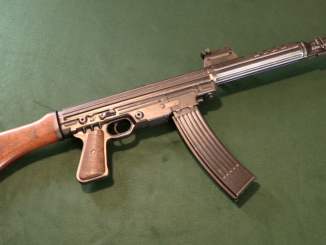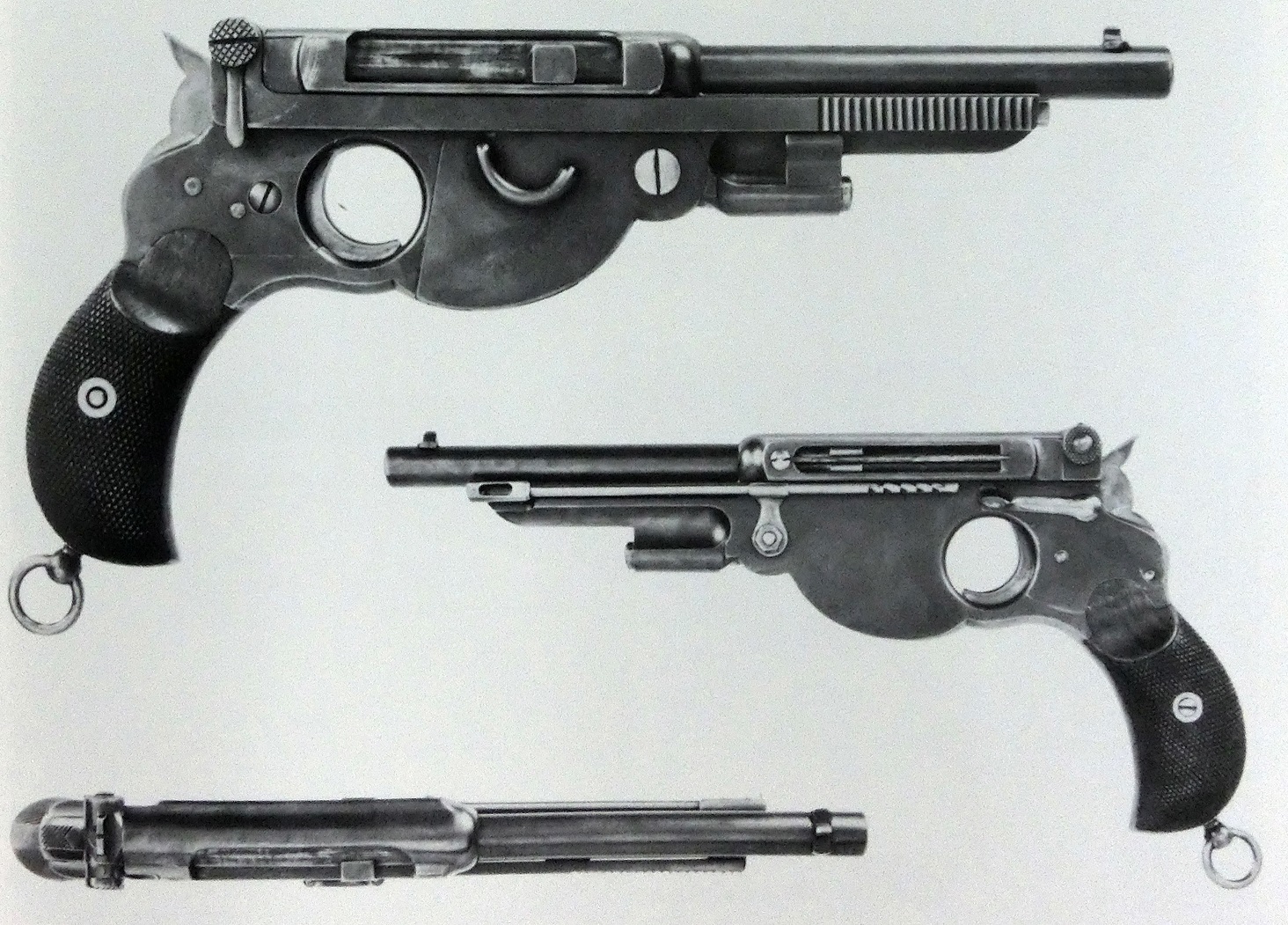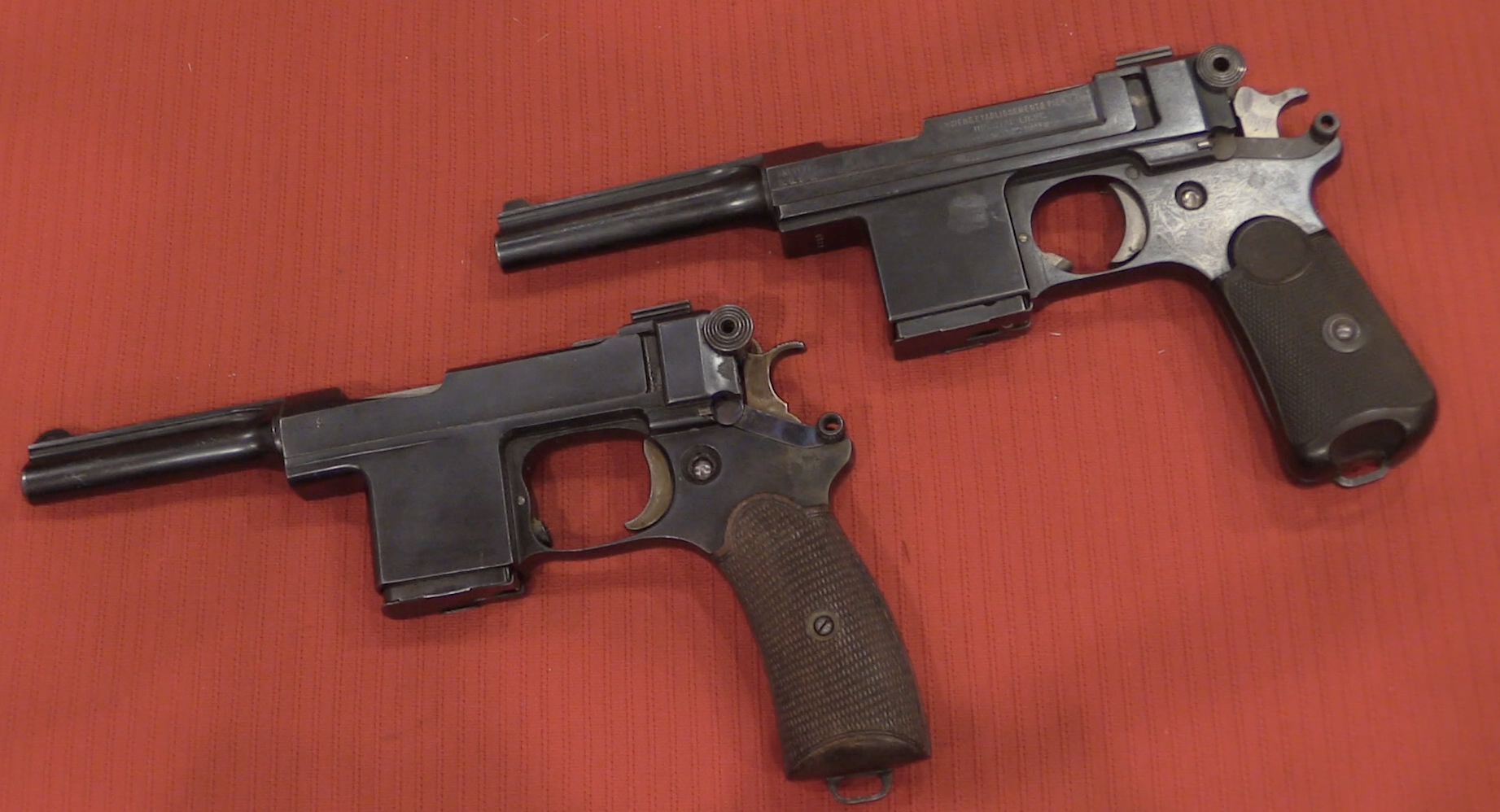The model 1900 was a transitional pattern of Mannlicher pistol, intended to be an improvement over the somewhat clumsy and underpowered Mannlicher 1896. Only about 250 of them were made, with an eye towards military contracts (which they were unable to secure). The 1900 pattern has a large manual thumb safety on the left side, and requires a screwdriver for disassembly. The 1901 pattern would improve these features by replace the disassembly screw with a spring-loaded lever and moving the safety to the rear of the slide. However, Mannlicher had several Model 1900 pistols magnificently engraved and presented to European royalty in his efforts to win military adoption of the design. Today, we have the examples presented to Sultan Abdul Hamid II of the Ottoman Empire and Wilhelm II of the German Empire, as well as one slightly lesser example given to one of Abdul Hamid’s adjutants.
Related Articles

Select-fire Rifles
MKb-42(W) – The Sturmgewehr That Never Was

Bergmann


One of those boxes you claimed belonging to Sultan Abdulhamid is in fact belongs to an Egyptian Khedive as the armada with the crescent is Egyptian Khedive armada…
That’s really interesting!
https://en.wikipedia.org/wiki/Khedivate_of_Egypt
I look at Japanese swords and see that the accoutrements — scabbard, hilt, guard — are decorated, but not the blade, the working part. Fighting is no problem. I look at these incredible engraved guns, whose every surface is a work of art, and I ask, Who actually dared to shoot one? Or even take it out of the box? Especially in the age of corrosive ammunition? Did the servants scrupulously clean and lube after each target session?
And speaking as a minimalist, I find that the “plain” Mannlicher, between its clockwork-precise machining and its high-polish blue, is plenty beautiful in itself.
Have a look at British 18th and 19th century embellished swords. There is plenty of blue and gilt work on the blades as well as on the hilts.
Top end European medieval armour was also often elaborately embellished. Sets of exquisitely decorated armour were given as diplomatic gifts between monarchs.
These sorts of decorative art were transferred to pistols when those became something that a person of high rank would be seen wearing or possessing.
Embellished automatic pistols are a natural outgrowth of these, and carried on an existing tradition on a new medium.
Kaiser Wilhelm surely fired that. He was crazy about shooting.
Disclaimer: I know nothing of the history of these companies, but the inscription on the regular one probably reads like this:
“Mun. & Waffenfabr. Soemmerda A.-G. vorm. V.Dreyse”
Mun. = Munition = ammunition
Waffenfabr. = Waffenfabrik = arms factory
Soemmerda = Sömmerda = town in Thuringia
A.-G. = Actiengesellschaft = joint stock company, akin to Inc. or Ltd.
vorm. V.Dreyse = vormals Von Dreyse = formerly Von Dreyse
The other inscription
Rhein. Met. U. Masch. Fabr.
Abt. Sömmerda Gewehrfabrik
Ehrhardt Werke
Rhenish Metal and Machine Factory
Sömmerda Division Rifle Factory
Ehrhardt Works
would seem to indicate that the factory in Sömmerda, originally built to produce Dreyse Needlefire guns, was taken over by another entity afterwards, namely the one named above.
I have no clue about the inscription meaning.
But regarding the factory at Sömmerda, it is indeed the former Dreyse rifle factory, which could no longer prosper in the time of metallic cartridges. Practically bankrupt, it was sold by Dreyse’s son to Rheinmetall (founded by Heinrich Erhardt). Rheinmetall produced small arms, particularly pistols and machine guns, there, as well as small arms ammunition (military headstamp H, commercial RM S). It was the place where designer Louis Stange worked.
Note that the Dreyse rifle factory is not the same as primer manufacturer Dreyse & Collenbusch of Sömmerda, which is older and continued to exist in parallel.
Just stopping by to see if you were still on the Bergmann kick and I almost choked when I saw this, thankfully I think it’s safe.
Am I the only one that finds these things just garish, overly decorated and vaguely nauseous. Like a tarts boudoir
All the rage in 1900; a tarts boudoir… I mean sometimes I don’t think “progress” so called, in the “modern” world, is? Is progress?? No, is it just me.
I can’t imagine a handgun much less use than this one to the Kaiser, with his withered up left hand and arm.
And that notion of; Kings, contributed to WW1 Queen Vics extended family fell out and sent the “pawns” forth, in a game of Kings & Queens. With mass produced machine guns and breech loading heavy artillery… Mind you Wilhelms Dad seemed ok, so perhaps interelated monarchs seemed a good plan for peace; prior.
https://en.m.wikipedia.org/wiki/Cecilienhof
Nice bit of kit.
https://en.m.wikipedia.org/wiki/Frederick_III,_German_Emperor
Wilhems dad; more sensible… I read that book: https://en.m.wikipedia.org/wiki/The_Rise_and_Fall_of_the_Great_Powers
But it seems to me Germany would have just been better waiting till Britain fecked it up, as with Japan, no avoiding the bi-polar world, which both “winners” have fecked up, accordingly.
So, same thing; chill out.
I get why they didn’t chill out; social Darwinism etc, survival of the fittest! The superman, but meh… Germans minus Jews got pasted in WW2 whos Jews died as Germans in WW1.
People are people; better trying to work together.
Ian: I have a Mauser broom handle in 9 mm (c96) that has much the same treatment and would love to share some pics with you. A really interesting gun that poses a lot of questions that I believe you would enjoy delving into.